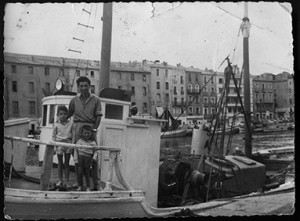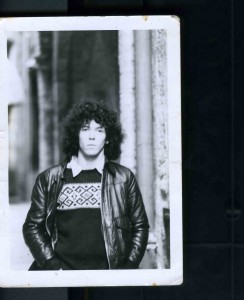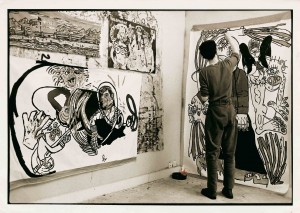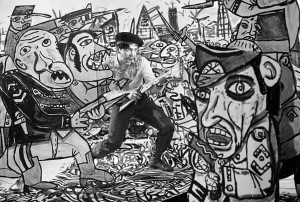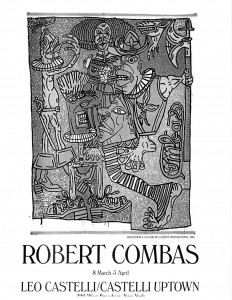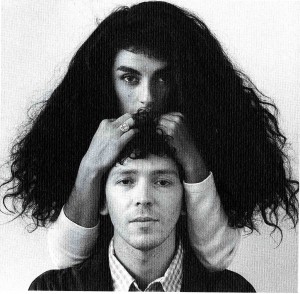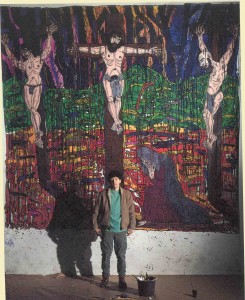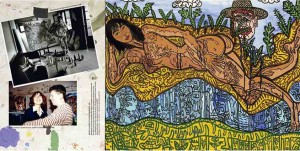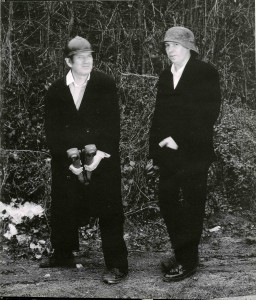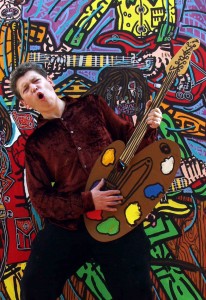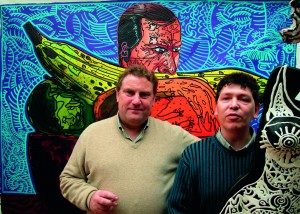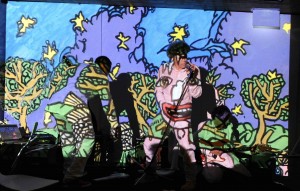1957
Birth of Robert Combas in Lyon on 25 May
Birth of Robert Combas in Lyon on 25 May
1961
The Combas family moves to Sète.
The art of Robert Combas is like a huge melting pot in which everything is mixed up, without hierarchy or discrimination, or a prism that both deforms and reveals his perception of the world, his experience and the universe of his imagination. All the things that were part of his childhood and teenage years in Sète are jumbled together – the local accent and patois, colours, brass bands, carnival costumes and processions, black humour and mockery, his parents, the Communist Party, music, girls, friends: it’s all there, this mash-up is digested in his art.
The art of Robert Combas is like a huge melting pot in which everything is mixed up, without hierarchy or discrimination, or a prism that both deforms and reveals his perception of the world, his experience and the universe of his imagination. All the things that were part of his childhood and teenage years in Sète are jumbled together – the local accent and patois, colours, brass bands, carnival costumes and processions, black humour and mockery, his parents, the Communist Party, music, girls, friends: it’s all there, this mash-up is digested in his art.
1966
Young Robert had been drawing battles since he was two. His parents, Raymonde and Mario, have never hung his pictures on the wall, but the astronomical quantity of his output makes them realise that he has a gift for caricature and they decide to encourage him. They can see their son as being destined for an artistic career and enrol him at the local art school.
1974
Does his foundation year at the local art school in Sète, preparing for the entrance exams for the regional art school in Montpellier.
1975
Combas enters the École Régionale des Beaux-Arts in Montpellier. The course he studies for the next two years is highly technical.
1977
Robert Combas, Ketty Brindel, Hervé and Buddy Di Rosa form a close band of friends united by their shared interest in rock and punk, comics and humour. Ketty and Robert start going out together. At the beginning of his third year, Combas chooses to major in print-making and painting. His many prints already show a distinctive style. Through one of them, Merde, he discovers the artist Ben Vautier. Print-making is very important to him but he finds the technique burdensome. However, it is by synthesising his different styles that he formulates the beginnings of what will later be called Figuration Libre. In addition to this “academic” work, he also does his own things on paper: battles, rock groups, the adventures of Fernand Zop and Mickey Combas, Tuer, and Ketty. Robert becomes more relaxed about technique. He realises that he has already produced huge amounts of drawings, and is already an artist. His new freedom stems from a number of facts that have made a deep impression on him: Bernard Palissy who burned his furniture and floorboards when he ran out of firewood for his kiln; Ladislas Kijno letting children walk on his works in an edition of Suzanne Gabrielo children’s show that he saw on TV when he was 11; and Jonathan Richman telling an interviewer that it would be good to start playing with untuned guitars. Seeking to do something new, he takes his own past as his starting point and the source of his classic themes, such as TV images, cartoons, and the battles he has been drawing since he was a young child.Having thrown off his inhibitions, he starts making a landscape on a huge piece of Kraft paper (now lost). The first canvas he paints is altered several times: it is broken up into four parts, and then into three, then Robert burns one of them and sticks bits of wool on another. These prefigure the drips he starts making in 1989. The artist has never seen this piece again.
1978
Painting supplies are expensive and the young artist’s background is modest, but so what! Combas recycles and paints on whatever comes to hand: cardboard boxes, tables, doors and sheets. He also re-uses works abandoned by students as the background for this first Mickey paintings. Throughout his career he continues to work on drawings by children or students and on the pages of magazines. These pre-existing forms, this reserve of materials, inspire him to create something new. He uses them exactly the way musicians sample. Robert Combas, Ketty Brindel and Hervé Di Rosa create Bato magazine, “an assemblagist, collective work of art hand-made in an edition of 100.” This collective spirit also sees Combas form the group Les Démodés with Ketty and Buddy Di Rosa. Their songs are like Dadaist nonsense rhymes wrapped up in brutal, simple music. They play at the Théâtre de la Mer in Sète, in Montpellier, Avignon, and even in Paris at the Golf-Drouot and the Gibus.
1979
It is this music that gets journalists talking about Combas. In the daily newspaper Libération, Jean-Pierre Thibaudat publishes the first two articles in the national press to mention his name. Both are about Les Démodés (“Fiction-rock en Avignon,” 23 July 1979; “Art caustique et vieilles dentelles. Les Démodés,” 1 August 1979). In September Ketty is given a part in Jean-Henri Meunier’s film La bande du Rex. Robert accompanies her to Paris for the shoot and discovers the Marais and above all the Barbès quarter, where he is struck by the cheap showiness of the objects and shop fronts, by the colours and mixtures, all of which chime with his Mediterranean background and make him feel at home. The hundred-odd drawings that he makes in his sketchbook will serve as a repertoire of motifs for his large-scale compositions. This is the beginning of what he calls his Arab Pop Art, a “Pop Art for developing countries” which could just as well have been called African Pop Art or Chinese Pop Art.
1980
He has his first solo show at Galerie Errata in Montpellier in May, followed in June by another in the rock bar run by his friends Pascal Saumade and Jacques Rue: Lieux Dix, Galerie MedaMothi in Montpellier. Combas obtains his diploma at the École des Beaux-Arts in Saint-Étienne, the city responsible for awarding diplomas that year. Contacted by a member of the jury, Bernard Ceysson comes to see his work. In August, having been declared ineligible for military service, Combas settles in Paris with Hervé Di Rosa, Ketty Brindel and Louis Jammes in the apartment rented by Jammes at 120 Rue de Charonne. They meet François Boisrond who, like Hervé, is studying at the École Nationale Supérieure des Arts Décoratifs in Paris. A friend of Hervé Di Rosa’s who is working at Promostyl for Arlette Lacour shows her a copy of Bato. Lacour buys several of the Arab Pop paintings Combas made when at the Beaux-Arts. Combas and Di Rosa tout their humorous drawings to Libération, which publishes them in its weekly supplement Sandwich. Others are published in Marie-Claire magazine. Bernard Ceysson invites Robert to show in Après le Classicisme, the exhibition being held at the Musée d’Art et d’Industrie de Saint-Étienne in late November. At the opening Robert meets Bruno Bischofberger, who will regularly buy his works up to 1982, and Daniel Templon, who buys one that very evening.
1981
Robert Combas starts working with the Parisian gallerist Chantal Crousel. In February he has his first show abroad, Objekte und bilder at Galerie Eva Keppel (Düsseldorf). Chantal Crousel introduces Combas to the Swart gallery in Amsterdam, which puts on a show in March. Robert Combas and Hervé Di Rosa meet art critic Bernard Lamarche-Vadel through François Boisrond’s father. He offers them an exhibition in June in his loft in Rue Fondary (Paris), which he is about to leave. They also meet Rémi Blanchard and Catherine Viollet, with whom they will form the nucleus of the show, Finir en beauté. Ironically enough, Lamarche-Vadel has already seen Combas’ battle paintings at the Beaux-Arts, when he told him that he was too late because the Transavanguardia had already made similar pieces. On 24 March the newspaper Libération publishes the first French article about Combas the artist, “Trop pauvre pour se payer une toile”, by Patrice Bollon.On 29 September Libération publishes “Pas d’orchidées pour Combas et Di Rosa” in relation to the exhibition organised by Ben Vautier, 2 Sétois à Nice. In this article Ben cites Combas and Di Rosa as the French representatives of an international tendency which he calls Figuration Libre. In October Hervé Perdriolle presents To end in a believe of glory [sic] at the Espace des Blancs Manteaux (Paris) and exhibits Combas, Boisrond, Di Rosa, Blanchard and Viollet. November: Combas takes part in the Ateliers 81/82 exhibition at the ARC-Musée d’Art Moderne de la Ville de Paris. The Démodés play at the opening. On 11 December Otto Hahn, publishes “Allons enfants de Picasso” in the weekly magazine L’Express and cites Combas as the leading figure in the Figuration Libre movement. At the end of the year Robert Combas and his friend Marc Durand rent a small apartment on the seventh floor (with no lift) at 17 Boulevard Saint Marcel. Ketty joins them. Robert has no studio and so, as usual, paints at home – in this case, in the cramped kitchen.
1982
Combas is shown for the first time in the US as part of Statement One, a selection of French artists at Holly Solomon Gallery, New York. March: first solo exhibition in Paris with Yvon Lambert, the beginning of an intense and stimulating collaboration. October sees the first exhibition explicitly by the Figuration Libre artists: Figuration Libre: Rémi Blanchard, François Boisrond, Robert Combas, Hervé Di Rosa, held at the Swart Gallery in Amsterdam.
1983
Blanchard, Boisrond, Combas, Di Rosa at the Groninger Museum (Netherlands). Les Démodés play at the opening. First solo show in New York with Leo Castelli. Robert exhibits at the Il Capricorno gallery, Venice, in May. Sabine and Nini Camuffo are fervent supporters who began working with him in 1982, after discovering his art at Ben’s 2 Sétois à Nice exhibition.Also in May, the Galerie Le Chanjour shows Combas’ work in May in Nice. Their collaboration will continues until 1989. At the end of the year Ketty and Robert move to 17 Quai Louis Blériot, opposite the statue of Liberty Enlightening the World. Combas is now enjoying greater financial stability: his paintings are selling well. Conscious of his luck in being able to work freely, he devotes himself to his art. 1983 is a turning point: his painting is developing, his imagination expanding vigorously and his canvases are becoming fuller, more sophisticated and complex. Yvon Lambert advises him to move to a bigger space.
1984
Combas and Ketty rent a big house in the Marais at 30 Rue du Parc Royal. The Combas style is becoming increasingly confident. The works are spectacularly dense and the subjects increasingly complex. Combas’ visual hallmarks are now present in his works: black outlines around the colour. The ARCA art centre in Marseille holds the first large-scale exhibition of Combas’ work and publishes his first monograph catalogue, Combas 84. In December the Musée d’Art Moderne de la Ville de Paris organises the exhibition 5/5 : Figuration Libre France/USA, juxtaposing work by young painters from France (Blanchard, Boisrond, Combas, Di Rosa, Jammes) and America (Basquiat, Crash, Haring and Scharf). Coincidence or not, a few months later Haring starts painting figures that are strangely similar to the ones in Combas’ paintings.
1985
Still very young, he has a retrospective at the Musée de l’Abbaye Sainte-Croix at Les Sables d’Olonne, which tours to the Gemeente Museum in Helmond, the Netherlands, and the Musée d’Art et d’Industrie in Saint-Étienne in early 1986. For the FIAC at the Grand Palais in Paris, Combas appropriates works at the Louvre. His creations are presented in the booth of Galerie Yvon Lambert. The gallery’s suggestions are helping Combas diversify and encouraging him to take on the great themes of art history.
1986
In March he has a second solo show in New York at Leo Castelli. Combas takes part in the exhibition Luxe, calme et volupté at the Vancouver Art Gallery in Canada, where his works are seen in relation to pieces by major names such as Gérard Garouste, Daniel Buren, and Martial Raysse. Robert Combas and Ketty move, renting from Sophie Calle a spacious, light apartment in an old factory building on Boulevard Camélinat in Malakoff, on the southern edge of Paris. The artist starts making works on clothes.
1987
Robert and Ketty split up. Combas’ way of working is, as ever, urgent and chaotic. Realising how much material he is wasting, he decides to recycle and starts using old brushes and paint tubes to make sculptures. These are his first small crucifixes and painted brushes. In March the CAPC in Bordeaux mounts a personal exhibition which will tour to the Stedelijk Museum in Amsterdam. He features in L’époque, la mode, la morale, la passion, opening in March at the Musée National d’Art Moderne, Centre Georges Pompidou, Paris. In June he meets Geneviève Boteilla at a party given by a collector and client of Yvon Lambert. She will become his companion and muse. Given that Combas’ works are like the pages of a private diary, this change is manifest in his work. The theme of love is increasingly prominent in his paintings as is Geneviève herself. They live together in a house in Antony, waiting for Combas to be attributed a municipal studio in Paris.
1988
Jointly with Yvon Lambert, Combas also starts working with Marianne and Pierre Nahon (Galerie Beaubourg, Paris). The relationship continues to 1992. The galleries twice put on simultaneous exhibitions on related themes.In September there are two simultaneous exhibitions on one of his favourite themes, war: La guerre de Troie at Galerie Yvon Lambert and Les batailles at Galerie Beaubourg. The two Parisian galleries also initiate a monograph on the artist. L’amour à 2 at Galerie Pierre Huber in Geneva exhibits works showing the private life of Geneviève and Robert. In December Combas and Geneviève move to a two-floor apartment in Rue Doudeauville, Barbès.
1989
The City of Paris give Combas his first real studio in Rue Quincampoix. He will continue to work there until 2002. The Fondation Cartier commissions him to do all the visuals for the exhibition Nos années 80, making his work emblematic of the decade. In September he has his first exhibition in Korea at the Blue Gallery, Seoul. He starts working in three dimensions, using concave frames and inserting objects into the canvas and the frame. Introduces him to religious art by showing him round churches and cathedrals. He is deeply affected by the icons and stained glass he sees. Combas’ painting moves towards a “spiritual” style. The drips begin to appear. He takes an interest in alchemy, religion and medieval art.
1990
The exhibition at the Wolf Schulz Gallery in San Francisco in February is the first to feature the new “dripping” style. The one put on at the Musée Toulouse-Lautrec in Albi, Combas-Toulouse-Lautrec, highlights the artist’s formal evolution. It also causes ructions on the museum board: the canvases are judged shocking. The exhibition tours to the Musée de Blois and to the Taipei Fine Arts Museum in Taiwan.On 11 July Robert Combas is condemned to pay a “symbolic franc” to Jean-Paul Belmondo for having insulted his image by including his face in a work from 1984. Geneviève makes Robert Combas : L’alchimie du verbe, a documentary portrait of the artist.
1992
Sète puts on two simultaneous exhibitions: Aquestécop, in which Combas shows works made since 1977 and La mauvaise réputation, in which he expresses his vision of the songs of Georges Brassens. Galerie Moser in Geneva puts on the first exhibition of the “Academic Tattoos” on paper.1993 The exhibition Du Simple et du Double at the Musée d’Art Moderne de la Ville de Paris presents paintings inspired by the texts of Sylvie Hadjean. Combas’ works in red chalk are shown for the first time, as is the large stained-glass piece, the Dormeur Duval.
1994
The exhibition at the Manoir de Cologny (near Geneva), Dessins, peintures, meubles peints, features the first paintings on records.
1997
The exhibitions Œuvres récentes at Galerie Charlotte Moser (Geneva) and Diou mé damné ! Macarel ! Je fais une rétrospective at Villa Tamaris (La Seyne-sur-Mer) feature new works done on magazine pages.Portraits glitter brillants at Galerie Laurent Strouk (Paris) features relief paintings.
1998
The exhibition Ben et Combas – Entre deux guerres shows the two artists together at the Historial de la Grande Guerre in Péronne. They separately produces works expressing their vision of the 1914–18 War. Combas paints on photographs made on the shoot of Les croix de bois, a film made in 1931 by Raymond Bernard, which he was impressed by four years earlier, and on photographs of the Great War.
1999
For the exhibition Ex Originibus picturae at the old bishop’s palace of Sarlat, Combas works on the theme of Lascaux and prehistory during a three-month residency in a disused aquarium building. This exhibition revives the intense pleasure he takes in the act of painting, and also his use of large-format canvases – one of them is five metres long and represents a shaman, flute in hand, chasing an antelope. Combas creates an effect of volume by inserting the sticks used for stirring syrup, ending in colourful butterflies. The exhibition is also noteworthy for the diversity of media on show.The exhibition Tronche d’habits at Espace Cardin in Paris features a series of works done on clothes. Most of these sculptures/canvases are shown in light-boxes. A room with sound is set aside for three works on the theme of the symphony orchestra.
2000
Held simultaneously in three different galleries – Charlotte Moser, Geneva; Rachlin Lemarié, Paris, and Dewart in Brussels—the exhibition Marilyn Combas in June) sees the artist appropriating the absolute icon of femininity, Marilyn Monroe, much as he has done in his early days with Mickey Mouse. Working directly on reproductions of silkscreens by Andy Warhol, Combas offers a very different vision, breaking up the smooth, stereotyped face of the sex goddess to recapture the plurality of her humanity as a woman. The exhibition catalogue is an object in its own right complete with CD in which the artist gives a rhythmic rendition of his works titles-cum-texts to a musical background. Held at the Musée Paul Valery, Sète, in July, the exhibition Maï aqui features paintings evoking the artist’s childhood memories of Sète.
2002
Combas moves his studio to Ivry-sur-Seine. This is the first time he has owned his work space. He meets the Belgian gallerist Guy Pieters: this is the beginning of a stimulating and challenging collaboration. Une expo d’été de musique et d’images at Galerie Hélène Trintignan in Montpellier is a striking homage to music. Combas shows works that synthesise his childhood memories and school-book drawings of rock groups, his interest in music (rock, jazz, blues, etc.) and new techniques that he is beginning to try out. The exhibition Les vieux dégueulasses (ou voici où en est la liberté d’expression) at Galerie Metropolis, Lyon, in June features a series of Academic Tattoos which Combas combines with texts that verge on the disgusting. The point is not so much to provoke as to reflect an age when sex is everywhere. They are also a reference to Sète and the characteristically colourful speech of its inhabitants.
2003
Galerie Guy Pieters at Knokke-Le-Zoute, Belgium, exhibits paintings of still lifes and the artist’s friends and family.
Combas does a two-month residency in Aix-en-Provence, where he exhibits in eight different spaces for a “Combas Season”. He executes a set of large-format paintings on the themes of the Middle Ages, courtly love, King René, and Cézanne’s Mont Sainte-Victoire. Exhibiting at the Cité du Livre gives him the chanced to develop the use of writing in his paintings. Like the pages from a private diary, eight works reveal his most intimate doubts and thoughts. Robert Combas starts working with Ladislas Kijno. Galerie Charlotte Moser in Geneva shows how Combas’ experiments have developed: his illustrious tattooed figures are now glued on the canvas and edged with bright paint, setting up a contrast with the matt finish of the paper and the lines.
Combas does a two-month residency in Aix-en-Provence, where he exhibits in eight different spaces for a “Combas Season”. He executes a set of large-format paintings on the themes of the Middle Ages, courtly love, King René, and Cézanne’s Mont Sainte-Victoire. Exhibiting at the Cité du Livre gives him the chanced to develop the use of writing in his paintings. Like the pages from a private diary, eight works reveal his most intimate doubts and thoughts. Robert Combas starts working with Ladislas Kijno. Galerie Charlotte Moser in Geneva shows how Combas’ experiments have developed: his illustrious tattooed figures are now glued on the canvas and edged with bright paint, setting up a contrast with the matt finish of the paper and the lines.
2004
The exhibition Tatouages académiques at Galerie Hélène Trintignan in Montpellier shows a new development in the work, with larger formats and greater numbers of figures.
2005
The exhibition En avant la musique at the Palais Bénédictine in Fécamp presents some two-score works on the theme of music made between 1982 and 2005. Robert Combas and Guy Pieters’ shared love of a challenge leads to the exhibition of the monumental Déesse Isis-Vénus at the exhibition Mots d’oreille mounted by Pieters on the fringe of the Venice Biennale. The work is housed in the superb Magazzini del Sale (Salt Warehouse), standing opposite ten large-format canvases whose metaphysical dimension exudes incredible energy. Combas’ works are presented at the exhibitions My favorite things at the Musée d’Art Contemporain in Lyon and in Big bang at the Musée National d’Art Moderne, Centre Georges Pompidou in Paris).
2006
The big retrospective Savoir-Faire is put on thanks to the work of Jean-François Mozziconacci and Jean-Luc Maslin. The show tours to South Korea, helping to consolidate the artist’s reputation internationally. It opens at the Seoul Museum of Art, then proceeds to Kyongnam, the Gyeongnam Art Museum, Changwon and the Asiana Museum, Daejeon. Galerie Hélène Trintignan in Montpellier puts on Combas-Kijno Œuvres. Galerie Guy Pieters presents the exhibition One man show Robert Combas during Art Paris at the Grand Palais. The Academic Tattoos are now fully-fledged paintings. Combas is using a new paint with metallic highlights and bright colours that react to light. He paints the ground and frame then heightens the ground using matt paint. The combination of glossy ground and matt overpainting creates vivid variations in light.Works by Robert Combas feature in the exhibition Il était une fois Walt Disney at the Galeries Nationales du Grand Palais in Paris.
2007
Robert and Geneviève make the studio at Ivry-sur-Seine their home. Held during the Cannes Film Festival, the exhibition Cinéphage à gogo at the Centre d’Art La Malmaison in Cannes features a selection of works on movie themes, done in a great variety of media. Also at this time a statue paying homage to Goscinny is inaugurated. This work is doubly a homage to the writer of the Astérix books because it is made up of the letters of the word “scénariste” (writer, scriptwriter). Chemin de Croix Combas-Kijno is exhibited at the Hospice d’Hâvré, Maison Folie in Tourcoing) and, the following year, at the Chapelle Saint-Louis, Manufacture des Gobelins, Paris. Kijno and Combas show a work made between 2003 and 2005, a product of the friendship between the two artists: fourteen panels retracing the Passion of Christ. Kijno began the works and sent them on to Combas, who reworked them. The power of Combas’ colour and outlines underscores the force of Kijno’s explosions of liquid and big black marks.
2008
The exhibition Qu’es Aco ? at the Fondation Van Gogh in Arles features, among others, paintings, sculptures, ceramics and small gouaches. The series of Mediterranean grandmothers reflects the painter’s fondness for the cultural melting pot of the Mediterranean.
2009
Combas buys a new studio at Les Lilas. The exhibition Le frimeur flamboyant at the Maison Européenne de la Photographie in Paris gives Combas the chance to go back to his work on photography and reproduction, and to respond to photography as a painter. By means of retouching and painting, he breathes new life into these portraits on glossy paper. Freedom, Diversity and Oppression at the Danubiana Meulenstein Art Museum, Slovakia, conveys the incredible freedom with which Combas diversifies his subjects and media. It includes the monumental sculptures La Déesse Isis-Vénus and Les deux guerriers
2010
The exhibition Sans filet, les Goulamas sont dans le trou at Galerie Guy Pieters in Paris marks the artist’s comeback on the Paris art scene. The artist takes on the theme of the Fall by offering his interpretation of Paradise Lost by John Milton (1667). His style continues to evolve: by synthesising his earlier work on volume, he achieves a three-dimensional effect with the bodies of his figures, which literally project forward from the canvas. His works now are lighter and, by the play of the contradictory energies transposed onto the canvas through the medium of paint, Combas draws us into a whirlpool of emotions. At this exhibition Combas meets Lucas Mancione and the two men embark on a prolific musical collaboration.
2011
Combas and Mancione compose over forty songs and produce accompanying videos to express the music visually. Nearly thirty years after Les Démodés, Robert Combas, Lucas Mancione and Pierre Relxach form a group: Les Sans Pattes. The Sans Pattes give their first live performance for the tenth birthday of the Musée International des Arts Modestes and at the Voix Vives de méditerranée en méditerranée poetry festival. Both events are in Sète. They later play with percussionist Gaël Managou during the exhibition Continents psychédéliques, organised by the Centre Culturel Français in Pointe-Noire in Congo. The year is dominated by an attempt to synthesise deep, basic feelings in a unified piece of work. When a person seems unable to grasp the gist of what they are hearing, the other person often says, “Do I have to draw you a picture?” In the case of Combas, we could now add, “Do you want me to play you a song?” Robert certainly talks (God knows he does!), but he is never as clear as when he is expressing himself in his creative work. His art has always been very human, and, whether painting or making music, he always puts all his feelings, from the most beautiful to the darkest, or wildest, into what he does. He builds cathedrals of emotion and sensitivity. His works are becoming more spare, the colours getting softer, showing us the palette of emotions that Combas has communicated to them, as if he wanted them to come to life and explain to us what we otherwise might not have grasped.
2012
Robert Combas retrospective at the Musée d’Art Contemporain in Lyon: Greatest Hits, on commence par le début, on termine par la fin, from 24 February to 15 July. Watch this space…Isis Chiappe-Canavelli, January 2012.
To be continued...
![[EN] Combas.com](https://www.combas.com/en/wp-content/uploads/sites/3/2016/01/logo-reseau.png)
